
"Heidik" No More: Neeme Järvi in Estonia
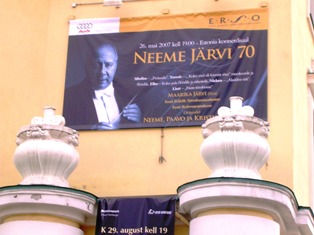
Banner announcing Neeme Järvi's 70th birthday concert at "Estonia" concert hall in Tallinn, June, 2007
|
TALLINN, Estonia - Non-person? Outcast?
Hardly. When conductor Neeme Järvi celebrated his 70th birthday concert with the Estonian National Orchestra here last Saturday in the "Estonia" Concert Hall, he was introduced by Estonian President Toomas Hendrik Ilves
himself.
Ilves recalled a time when Järvi, now music director of the New Jersey Symphony Orchestra, was heidik (Estonian for "outcast") in his native land. Recordings were released without his name and not credited to him on Estonian Radio. Articles, pictures and references to him were deleted from magazines and newspapers.
"Soldiers worked all night to take them out," Järvi recalled at a breakfast the day after the concert.
Järvi, his wife Liilia and their three children left Estonia in 1980 and came to the U.S., where they lived first with a family in Rumson, New Jersey. One of the Soviet Union's best known conductors, he was weary of the ceaseless restrictions on his activities. The last straw was in 1979, when he clashed with authorities over an unauthorized performance of Arvo Pärt's Credo.
Järvi was welcomed back with open arms after Estonia regained its independence in 1991. His fame spread far and wide after leaving the Soviet Union, and he remains one of the world's best known living Estonians.
"We are very proud we have a person like Neeme," said Andres Siitan, executive director of the ERSO (the orchestra's Estonian acronym). "He is, of course, a very big legend. Many people still remember when he was here, and
when he returns, it is always a big event."
Pärt was in the audience for the sold-out jubilee concert (Järvi's actual birthday is June 7), as were composers Veljo Tormis, Peeter Vähi and Eino Tamberg, conductor Olari Elts and pianist Vardo Rumessen, all Estonians, and
Swedish sculptress Britt-Marie Jern, creator of the bronze bust of Järvi
unveiled in the lobby before the concert.
Most important to Järvi was the presence of his entire family. Sons Paavo and Kristjan, both conductors, and daughter Maarika, a flutist, shared the stage with him. It was the first time they have all performed together. The six Järvi
grandchildren, plus numerous in-laws, nieces, nephews and cousins, were also on hand, either at the concert or the family breakfast the next day.
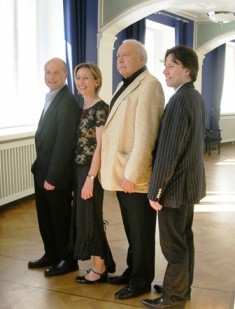
(left to right) Paavo, Maarika, Neeme and Kristjan Järvi at the "Estonia" Theater in Tallinn, June, 2007
|
Born in Tallinn, Järvi studied at the Leningrad Conservatory under some of the great Russian maestros, including Nikolai Rabinovich and the legendary
Yvgeny Mravinsky, conductor of the Leningrad Philharmonic. He began conducting the Estonian Radio Orchestra (predecessor of the ERSO) in 1960 and served as its chief conductor (1963-79), as well as head of the Estonian National Opera (1963-75).
In 1971, he became a national hero by winning first prize in the International Conductors Competition at the Accademia Nazionale de Santa Cecilia in Rome.
Järvi's other posts have included:
- Chief conductor, Gothenburg Symphony (National Orchestra of Sweden), 1982-2004
-
Music director, Royal Scottish National Orchestra, 1984-88
- Music director, Detroit Symphony Orchestra, 1990-2005
His huge repertory encompasses 417 recordings (as of last count in May, 2007).
Regarding the NJSO (his contract expires next season), the future "depends on our relationship, what we're going to do," Järvi said. "We have one problem. This is our stringed instruments which we bought (the Golden Age Collection, 30 Old Masters, including a dozen Stradivarius violins, donated to the orchestra by Herbert Axelrod at a questionable valuation in 2003).
"A very good idea, but it cost money. Its not $1 million, it's $18 million, and you have to pay for that.
"Paychecks is what we're in trouble with because we don't have such a large endowment. We have to find a way to change things with less, not to make such big programs with special extra musicians. But music may still be exciting.
"People don't know very much our problems. They are just coming to concerts to be happy. We will continue to make music. The orchestra is excited, we're a fantastic team. Contracts you can adjust."
Järvi carefully hand-picked the program for his birthday concert in Tallinn, Liszt's "Faust" Symphony and a sheaf of Nordic music, including works by Estonians Villem Kapp, Tormis and Heino Eller, Danish composer Carl Nielsen and Finland's Jean Sibelius.
Järvi led Kapp's "Põhjarannik" ("North Coast)", Tormis' "Kolm mul oli kaunist sõna" ("I Had Three Beautiful Words") and the Liszt. Paavo conducted Sibelius' "Finlandia." Kristjan led Eller's Three Pieces for Flute and String Orchestra (orchestrated by New Yorker Charles Coleman) and three movements of Nielsen's "Aladdin" Suite.
A key participant was the Estonian National Male Choir. "If there is one great institution that is like the Estonian National Orchestra, it is the male choir," Järvi said. Heard in five of the six works on the program (all but the Eller), it was a unifying presence. Nielsen's "Aladdin" is never heard with voices, Järvi explained. "To hire chorus for two movements is very expensive."
The "Estonia," a handsome Jugendstil building dating from 1913, is where Järvi served as chief conductor of the ERSO and the Estonian National Opera.
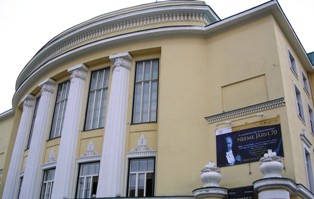
"Estonia" Theater, Tallinn, Estonia
|
The concert hall, a gracious shoebox with blue velvet seats -- red is not so popular in former Communist Eastern Europe -- seats 889. Eight cameras, two onstage, ringed the hall. The stage was flanked with white roses and purple irises.
Järvi's trademark blue handkerchief peeked from the breast pocket of his formal long coat by Estonian designer Arne Niit, who also created Maarika's long black dress ornamented with tufts of blue, white and black (Estonia's national colors). Brothers Paavo and Kristjan dressed more conservatively in a mandarin jacket and a charcoal sport coat, respectively.
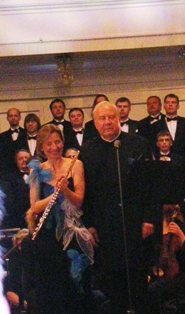
Flutist Maarika Järvi with Neeme Järvi, "Estonia" Concert Hall, Tallinn, June, 2007
|
Kapp's 1958 tone poem, very popular in Estonia, opened on a heroic note. Tormis' genial work juxtaposed Maarika's perky, birdlike flute against verses tapered just-so by the male choir.
"Finlandia" had implicit political resonance in light of the riot by Russian-speaking Estonians in late April, following the government's removal of the Bronze Soldier - a monument to the Soviet "liberation" (occupation) of Estonia in World War II - from Tönismägi square in Tallinn.
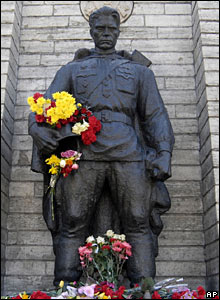
The Bronze Soldier, Soviet war monument removed from Tönismägi Square in Tallinn, Estonia, April, 2007
|
Sibelius' nationalistic work bristled more than usual in Paavo's hands, the undercurrent of string tremolo and timpani during the fervent hymn a reminder that tiny Estonia (1.3 million residents) remains vulnerable to nearby
Russia.
"When the Soviets came, 10,000 people were sent by animal cars to Siberia to die," said Järvi. "It was the beginning of hell for Estonia. It became a military base for the Soviet Union."
Estonia was caught in a vise between Nazi Germany and the Soviet Union, he continued. Soviet dictator Stalin forcibly annexed Estonia in 1940 pursuant to the secret Molotov-Ribbentropp Pact, whereby he and Hitler agreed to
carve up Europe. When Germany turned on the Soviet Union, Estonia
became a battleground, with soldiers conscripted by both sides.
"There was a Soviet-Estonian military, then Hitler came and the rest became Hitler/SS military. Fathers, brothers and sons were fighting each other. They had to, because otherwise they would be killed. Nobody understands this
situation," Järvi said.
Maarika painted Eller's nature sketches deftly (valley, river, meadow). Kristjan nearly stole the show with Nielsen's "Aladdin," a splashy work with its lumbering "Oriental Festival March," quadraphonic "Marketplace at Ispahan"and "Negro Dance," the last two movements pumped with octane by the male choir.
(Neeme) Järvi led a powerful, soulful Liszt. He conducted subtly, but with every sinew, allowing the listeners to feel the desolation in "Faust," the interweaving of the lovers' themes in "Gretchen" and the swelling emotion at the end of "Mephistopheles," as Faust's redemption was announced by the
choir and the resplendent Estonian tenor Juhan Tralla.
Rhythmic clapping accompanied Järvi's bows. (Pärt could be seen tapping triplets.) He clasped the musicians' hands, then waved to the crowd, signaling that there would be no encore (uncharacteristic for him).
The concert was taped by Jason Starr of Cultural Media Collaborative (New York) for a projected DVD. The concert will air on Estonian TV in late July. Also in town to work on a video documentary about the Järvi family was Manfred Scheyko of Hessische Rundfunk in Frankfurt.
Järvi is an orchestra builder, whose legacy to Estonian music was symbolized at a post-concert reception, where he was presented a scroll listing the programs he has led with the orchestra since 1956.
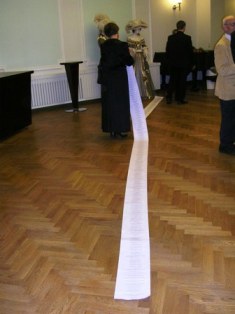
Neeme Järvi's "time line" (list of concerts with the Estonian National Orchestra, presented to him at his 70th birthday jubilee reception, "Estonia" Concert Hall, Tallinn, June, 2007)
|
"I have a philosophy," said Järvi. "It doesn't matter where I'm working. Music is music for me. I like to make music and make people happy with music."
By Mary Ellyn Hutton
(first published in The Newark Star-Ledger June 3, 2007)